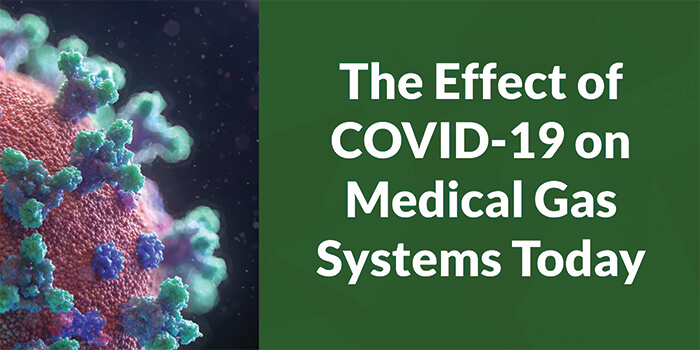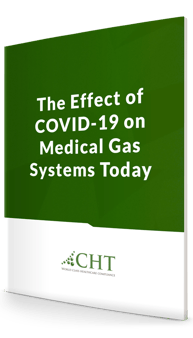
The past several weeks highlights navigating the COVID-19 pandemic, the hyper-realization of the vital importance of the medical gas system, and the effects of increased demand on this critical infrastructure. As a result of pushing these systems to, or even beyond their designed limits, additional risk factors have been realized and should be addressed in the weeks and months ahead. Below are some considerations to keep in mind during these unprecedented times.
While some areas and facilities have already experienced a peak in cases and are, hopefully, on a downward trend, other parts of the country are right in the middle of this crisis. And still, other areas have fortunately experienced little impact. And there is always the potential for a surge to reemerge in the future.
Regardless of an individual facility’s experience, now is the time to identify and evaluate potential risks and how to address them moving forward. While doing so, it is essential to remember that assessing these risks should not be based solely on the possibility of an asset failure, but on the overall impact that may occur when an asset does fail.

Increased Demand on Oxygen Delivery System
With an increased need for ventilators and the duration to which they are used, one of the most noticeable effects has been on the oxygen delivery system. To address potential pressure drops within the system as a result of the increased demand, some facilities have adjusted their final line regulators to increase the entire system pressure.
If this approach is taken, it is vital to remain within the NFPA 99 limits of 50-55 psi, as well as to adjust all area and master alarm high and low-pressure set points to stay ±20% of the operating pressure. And it is important to remember to document all changes so any alarm adjustments can be made when returning the system to its normal operating pressure.
While most facilities have not experienced any issues with the actual supplied volume of liquid oxygen, the vaporizers have been identified as a potential weak link in a bulk cryogenic liquid supply system. In some instances, the increased flow of oxygen to the facility has been beyond the designed limits of the vaporizer. This results in excessive icing on the vaporizers and failures of controls downstream of the vaporizers due to the liquid not converting to a gaseous state.
Most vaporizers rely on the movement of ambient air around the fins to allow the liquid oxygen to convert to gas. In times of increased demand, there are options available to combat excessive icing.
Potential short-term remedies include:
- Placement of fans around the vaporizer to increase airflow
- Ensuring proper timing of alternating type systems (if installed)
- Supplying additional capacity of oxygen through the emergency oxygen supply connection (EOSC)
- Back feeding individual zones
Installation of electric or steam vaporizer systems may also be worth assessing as a more permanent solution.
As required by NFPA 99, the suppliers of bulk cryogenic liquid systems shall provide an annual review of the source system to ensure it has sufficient capacity. Suppliers are also required to provide documentation of vaporizer sizing criteria to the facility upon request. It is recommended that all facilities work with their bulk suppliers during these annual reviews to identify any areas of potential risk.
Additional Resource:
AARC, Additional Ventilators May Pose a Risk to Hospital Gas Systems
Increased Demand on Medical Air Systems
Aside from the piped oxygen systems, increased demand has also been observed with medical air systems. Like the oxygen system, the increased flow of medical air can result in asset failures within the system. It is essential to provide frequent checks of these systems to ensure proper operation of medical air compressors, dryers, and filters.
Keep in mind that systems may require more frequent preventative maintenance as a result of increased usage. Areas of improvement may include increasing capacity through additional compressors or interconnecting with other medical air systems in the facility (if present).
Additional Resource:
Kaiser Permanente, Medical Air and Oxygen Capacity
Analysis of Piping Distribution Network
From a longer-term perspective, it is recommended that an analysis of the actual piping systems be performed to identify areas of the facility that could be used for patients requiring ventilators or any potential areas of improvement. As part of The Joint Commission Environment of Care Standard EC.02.05.01, a facility is required to map out the distribution of utility systems.
By knowing the layout and sizing of a piped medical gas system ahead of time, a facility can make educated, time-sensitive decisions as to the capabilities of their systems throughout the building. This will allow for a smoother transition should a facility elect to utilize different parts of the building for surge capacity.
Verification of New or Temporary Installations
With the surge of COVID-19 patients, many facilities have looked at adding new permanent or temporary alternate patient care spaces within their facilities. If either option is utilized, it is important to remember a verification is required for all medical gas installations.
NFPA 99-2018, 5.1.12.11, requires that inspection and testing be performed on all new piped gas systems, additions, renovations, temporary installations, or repaired systems. Ensuring the proper installation and testing of these systems is paramount to delivering safe patient care.
Ongoing Inspection,Testing, and Maintenance
To limit the spread of COVID-19, facilities struggle with the decision to limit the number of people walking through the doors of the hospital. This includes vendors providing ongoing inspection, testing, and maintenance services.
While medical gas technicians are considered essential workers and most facilities appear to continue with their regularly scheduled inspections, some have elected to postpone by applying for an 1135 Waiver from CMS. While perfectly acceptable to go this route, it is important to note that TJC and ASHE recommendations on deferment of medical gas annual inspections be resumed within 60 days of the state of emergency (SOE) being lifted.
Additional Resources:
ASHE, CMS has Issued a Blanket Waiver for ITM
ASHE, COVID-19 Emergency Declaration Blanket Waivers or Health Care Providers
Conclusion
While it certainly is not business as usual in the world of healthcare right now, it is important to continue addressing risk and staying focused on the needs of patients. While this can require thinking outside the box or considering different aspects of your medical gas system, it can also be a time to evaluate your existing system, develop new best practices, and determine how to be better prepared moving forward.
CHT remains committed to assisting our partners in navigating these difficult times to battle this pandemic together.




